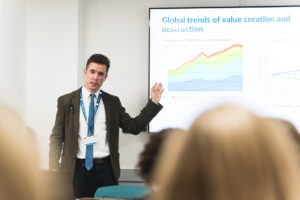
| Date | Author |
|---|---|
| 1st March 2023 | Tom Owen-Smith, SUMS Consultant |
(6-minute read)
The UK’s universities still have a long way to go towards reducing their carbon emissions. Although many have set ambitious reduction targets, a major report released last month by the Royal Anniversary Trust estimated that the carbon footprint of the UK’s higher education sector is larger than those of Latvia, Albania or Jamaica.
With a substantial challenge still facing the sector, SUMS Consultant Tom Owen-Smith considers how our institutions can make real progress towards Net Zero.
Targeting Net Zero in higher education
With the bulk of their activities based around knowledge and services, universities’ work is generally less energy-intensive than organisations that engage in material production and manufacturing.
In theory, that should make their transition to Net Zero – a state where carbon emissions have been reduced as far as possible and any residual emissions are balanced by like-for-like removals of carbon from the atmosphere – less of a mountain to climb.
On the other hand, most universities in the UK run on slim operating margins (which have been deficits for many over recent years), leaving them very limited resources to invest into decarbonising their operations – a cost which could run into tens or even hundreds of millions of pounds for some institutions.
So how can universities move the dial on their emissions and what’s the best approach to support their journeys towards achieving Net Zero?
A systematic approach
Our members often tell us that multiple initiatives are already underway at their institution, but these efforts are not always joined up. While taking action is positive in itself, being more systematic maximises the benefits that can be achieved for the resources put into decarbonisation.
Understanding the full picture of your current emissions profile is crucial. The recently published Standardised Carbon Emissions Reporting Framework for Further and Higher Education will help with this.
This information will allow you to consider the most material planks of your institution’s carbon footprint and systematically identify the range of actions that you might conceivably take to reduce them. Setting ambitious targets for reduction can spur institutions towards action – ideally these should be stretching and even visionary, but with some realism baked in around how they will be achieved.
Next, select and plan delivery of those actions which are both most impactful and most feasible for you to implement. A portfolio approach – in which individual initiatives are assessed and delivered with attention to their contribution to the whole agenda – is well-suited to this context.
Different areas of focus will be required for what are referred to under the Greenhouse Gas Protocol as scope 1, scope 2, and scope 3 emissions. Respectively these refer to direct greenhouse gas emissions, indirect emissions from purchased energy, and other indirect emissions.
While scope 1 and 2 emissions are under more direct control for an institution than scope 3, addressing all scopes is essential for reaching Net Zero.
Scope 1 and 2 emissions
Universities’ main contributors to scope 1 and 2 emissions tend to be heating and powering their buildings.
Many institutions will have switched to electricity generated from renewable sources (supporting emissions reduction in scope 2). Heat represents a trickier problem – in many cases, it is still supplied from gas-based central heating systems (which contribute to scope 1). Much “low-hanging fruit” around improving energy efficiency has already been harvested, meaning that the remaining potential for further reductions is likely to be complex and expensive.
Institutions should get the most comprehensive view possible of their existing estate and the potential for increasing its energy efficiency through retrofitting. This will provide clarity on the materiality of costs and benefits in the overall picture that can be expected from a particular intervention. Through that, a programme of investment to reduce building emissions as far as is feasible can be developed. Changes to how the estate is used, such as more consolidated space utilisation, can also make a difference.
If reducing the footprint of existing buildings can only go so far with current technologies (the remainder may eventually have to be offset), new buildings offer the opportunity to get things right the first time round. They should be built according to sustainable building standards, which are also likely to work out cheaper over the long term due to their enhanced energy efficiency.
The spiralling cost of energy over the last year has thrown all of this into sharp relief. Bills may have trebled; but to consider the positives, the payback period for energy-saving retrofits has shortened considerably, some interventions have become “spend to save” which were not previously so, and the financial case for energy efficient design has only strengthened. High energy costs also encourage organisations that have land (as some universities do) to explore possibilities for clean energy generation (one form of “insetting”) on their own estate.
Scope 3 emissions
Many institutions’ scope 3 emissions are three or four times the size of their emissions in scopes 1 and 2. Measurement of supply chain emissions in the education sector is still generally impressionistic and assumptions-based, but a coordinated approach to procurement focusing initially on the most material categories and the largest suppliers can be the start of the journey to understanding and reducing them.
A more direct approach can be taken for emissions from business travel, which are relatively measurable and controllable compared with other parts of scope 3. For now, institutions need to tread a line between ambitious reductions and incremental changes to long-established tenets of an academic career like attending international conferences. There are also consequences here for the way universities manage their global engagement and international recruitment strategies – the latter appears particularly challenging given many institutions’ reliance on international student fees to keep their finances breaking even. Partnership models may change as a result.
Scope 3 includes other areas such as employees’ commuting, emissions from homeworking and student accommodation – the last of which is particularly material. Each of these will require innovative thinking, experimentation, and potentially collaborative approaches with local government or other partners.
SUMS’ Sustainability consulting service
While your university’s sustainability teams will be well-versed in the issues discussed in this piece, it’s not uncommon for these teams to be stretched rather thin in many institutions (particularly at small providers). Similarly, sustainability teams are not always given the reach into university decision-making to secure leadership buy-in needed to make decisive changes on this wide-ranging agenda.
With this in mind, our Sustainability Service launched at SUMS Consulting last month. This service has been designed to inject expert resource where it is needed, allowing institutions to really move the dial around sticky and intractable sustainability issues.
Specifically targeted at the higher and further education sectors, the service is delivered in partnership with EAUC, the environmental and sustainability champion in the education sector. We provide access to recognised experts and leaders who bring deep knowledge of the topic and experience of creating change over a range of institutions inside and outside education.
If you’d like to know more about our Sustainability Service, more information is available on our website.
We’re also happy to discuss any topics raised here and what they could mean for you in more detail, free of charge. Contact Tom Owen-Smith at t.owen-smith@reading.ac.uk for more information.








